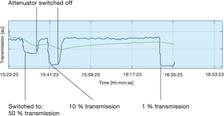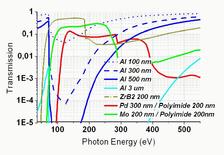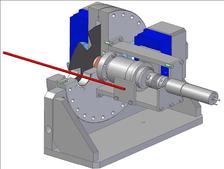The diagram demonstrates the performance of the attenuator. The blue curve shows the transmission signal in real time, while the green curve displays a time average with a time constant of 30 minutes.
Gas attenuator
The extremely intense FEL pulses from FLASH may destroy a sample in a single shot. Thus, for aligning delicate samples or determining the intensity dependence of processes without changing the beam characteristics, a windowless gas-filled cell with differential pumping units can be used. The attenuator is a windowless 15m long gas-filled tube which is installed between the FLASH machine tunnel and the experimental hall. Two pairs of GMDs in front of and behind the attenuator monitor the transmission of light.The attenuator is operated with either rare gases or nitrogen with a maximum gas pressure of about 0.1 mbar. Nitrogen covers an attenuation range of about four orders of magnitude in the spectral range of 19–60nm. Between 19 and 9 nm and for shorter wavelengths xenon and krypton can be used. Within minutes to tens of minutes the transmission can be reduced by orders of magnitude and re-established to 100%.
Filters
Spectrally, the FLASH photon beam consists of a strong fundamental and, to a much lesser degree, of higher harmonics. A suppression of the harmonic content or on the other hand, suppression of the fundamental and transmission of selected higher harmonics or a very quick reduction of the photon intensity are possible using metal foil filters. Both, the BL and the PG branch have filter wheels with
a variety of different metal foil filters. All filters are produced as self-supporting films without mesh support on frames with 10mm diameter apertures.
Fast shutter for single pulse selection
A rotating fast bunch train shutter has been developed at DESY for selection of individual photon bunch trains, repetition rates of below 10Hz, or, in case of one bunch operation, single pulses of FLASH . The shutter contains an aluminum disk which has six equidistant slits each providing a beam aperture of 20mm. The disk rotation in vacuum is generated by a special magnetic rotary feed-through combined with a DC motor outside of the vacuum system. The feed-through couples the rotation of the motor to the disk inside the vacuum without using bellows, mechanical or fluidic couplings. The shutter can be operated through the FLASH control system.
References:
[1] K. Tiedtke et al., The soft X-ray free-electron laser FLASH at DESY: beamlines, diagnostics, and end stations, New J. Phys. 11, 023029 (2009);
http://dx.doi.org/10.1088/1367-2630/11/2/023029
[2] S. Toleikis et al., Photon Science Report 2009. pp. 104-105 Annual Report








